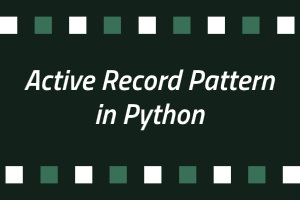Introduction:
Discover how the Active Record pattern, a powerful design concept, simplifies database interactions in software applications. In this article, we’ll delve into the Active Record pattern using Python examples, shedding light on its benefits and implementation.
Understanding the Active Record Pattern:
The Active Record pattern transforms complex database interactions into a seamless process. Rather than grappling with intricate SQL queries, this pattern treats database records as objects. Each database table corresponds to a class, and individual records are instances of these classes. By encapsulating database logic within classes, the Active Record pattern streamlines common operations and enhances code readability.
Active Record Pattern in Python – A Practical Example:
To illustrate the Active Record pattern’s functionality, let’s consider a basic user data management system built in Python:
- Class Definition: Begin by defining a ‘User’ class that mirrors the ‘User’ table structure. This class encapsulates attributes like ‘id,’ ‘username,’ and ’email.’
- Effortless Record Management: Inserting or updating records becomes hassle-free with the save() method. If a user is new (lacks an ‘id’), the method inserts a new record. For existing users, it updates the record.
- Finding Records: Retrieving a user by ‘id’ is made simple through the find(id) class method. This method queries the database and returns a ‘User’ instance.
- Seamless Updates: Modifying user details is as easy as updating the attributes and calling the save() method. The ‘User’ instance determines whether to insert or update based on the presence of an ‘id.’
- Efficient Deletions: Deleting a user is straightforward with the delete() method, removing the corresponding record from the database.
Implementation Example:
Below is a simplified code snippet exemplifying the Active Record pattern in Python:
class User:
def __init__(self, id, username, email):
self.id = id
self.username = username
self.email = email
def save(self):
if self.id is None:
# Insert a new record
# ...
else:
# Update the existing record
# ...
@classmethod
def find(cls, id):
# Query the database and return a User instance
# ...
def delete(self):
# Delete the record from the database
# ...
# Creating, saving, finding, updating, and deleting users
new_user = User(None, "john_doe", "john@example.com")
new_user.save()
found_user = User.find(new_user.id)
found_user.username = "johndoe"
found_user.save()
found_user.delete()
Benefits of the Active Record Pattern:
The Active Record pattern offers several advantages, including:
- Simplicity: The pattern simplifies database interactions, making code more manageable and comprehensible.
- Code Organization: By encapsulating database logic within classes, the pattern enhances code structure and maintainability.
- Efficiency: CRUD operations are executed more efficiently, thanks to streamlined interactions between objects and the database.
- Readability: The pattern’s clear structure and method naming conventions enhance code readability for developers.
Conclusion:
The Active Record pattern revolutionizes database interactions by treating records as objects. Python’s versatility and simplicity make it an ideal environment to implement this pattern, resulting in more efficient, organized, and maintainable code. Incorporate the Active Record pattern into your projects to elevate your database management processes and foster a seamless user experience.
Being the most extensively used JavaScript library, a jQuery certification will add enormous value to your skill-set. jQuery provides various functionalities to the developer in order to develop complex applications with ease and efficiency.




